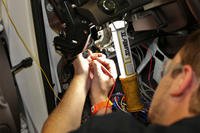Nissan might seem like it has been walking on the blade of a knife lately, but that isn't stopping its engineers from working on some amazing tech. The latest from the Japanese automaker is two patents uncovered by CarBuzz that could work in harmony. A method to help create a new lithium-oxygen battery and another that combines that with a new way to make a positive electrode for the cells.
Both filings acknowledge that current lithium-ion batteries have their problems. Battery tech companies and automakers alike are spending billions to try and develop new cell chemistries with higher energy density, lower costs, and reduced use of rare earth materials. Or at least some combination of the three that is better than what's on the market now.
Oxygen Battery Tech Could Become Mainstream

Toyota
Nissan has been working on solid-state battery chemistries. It plans to bring that tech to market as soon as 2029, though it has said it doesn't plan to rush. Lithium-air promises even higher energy density, but previous looks at the tech showed serious issues there, too. Problems like wasting much of their energy as heat and degrading quickly.
Now, Nissan's chemists and engineers may have solved those problems. The first patent covers a battery where the electrode is a layer containing lithium oxide, a catalyst, and a gel-forming polymer. They're applied to the surface of the collector and an electrolyte layer. It's a sealed-cell battery, solving one of the big problems with other attempts.
The second patent is similar, but it looks to address a problem of contamination within the cells. The patent says that if you try and charge to the theoretical maximum capacity of a lithium oxide cell, it generates a large amount of oxygen gas. This gas "means that the capacity of the battery is irreversibly lowered," it reads.
New Coating Is Like Bean-O For Your Battery

Nissan
To fix that, the second patent proposes adding a polymer coating to some of the lithium oxide electrodes. Coating it with a "branched polymer having a branched structure," the patent says, will reduce the amount of oxygen gas generated. So the battery can then be "charged to near the theoretical capacity of the lithium oxide."
The patent doesn't specify a particular branched polymer, which is good because it's a wide range of materials. It does suggest that the cell should use one or two from a group consisting of polypropylene oxide (PPO), polyacrylonitrile (PAN), vinylidene fluoride-hexafluoropropylene copolymer (PVdF-HFP), polymethyl methacrylate (PMMA), polymethylacrylate (PMA), poly (vinyl ethyl ether), polystyrene (PS), and styrene-butadiene rubber (SBR).
Read the full article on CarBuzz
This article originally appeared on CarBuzz and is republished here with permission.










